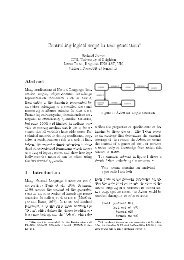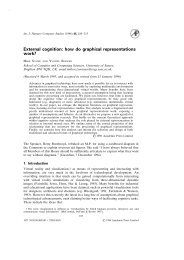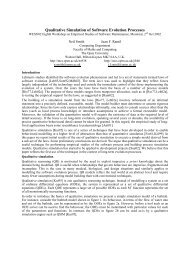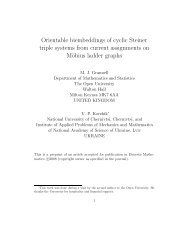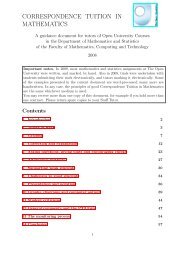admissible 3 - Faculty of Maths and Computing - The Open University
admissible 3 - Faculty of Maths and Computing - The Open University
admissible 3 - Faculty of Maths and Computing - The Open University
Create successful ePaper yourself
Turn your PDF publications into a flip-book with our unique Google optimized e-Paper software.
All <strong>admissible</strong> 3-(v, 4, λ) directed designs exist<br />
Mike Grannell, Terry S. Griggs <strong>and</strong> Kathleen A.S. Quinn<br />
Department <strong>of</strong> Pure Mathematics, <strong>The</strong> <strong>Open</strong> <strong>University</strong>,<br />
Walton Hall, Milton Keynes MK7 6AA<br />
This is a preprint <strong>of</strong> an article published in the Journal <strong>of</strong> Combinatorial<br />
Mathematics <strong>and</strong> Combinatorial <strong>Computing</strong>, 35, 2000, p65-70 c○(copyright<br />
owner as specified in the journal).<br />
Abstract<br />
In a t-(v, k, λ) directed design the blocks are ordered k-tuples <strong>and</strong><br />
every ordered t-tuple <strong>of</strong> distinct points occurs in exactly λ blocks<br />
(as a subsequence). We show that a simple 3-(v, 4, 2) directed design<br />
exists for all v. This completes the pro<strong>of</strong> that the necessary condition<br />
λv ≡ 0 (mod 2) for the existence <strong>of</strong> a 3-(v, 4, λ) directed design is<br />
sufficient.<br />
1 Introduction<br />
A t-(v, k, λ) directed design is a pair (P, B) where P is a set <strong>of</strong> v elements,<br />
called points, <strong>and</strong> B is a collection <strong>of</strong> ordered k-tuples <strong>of</strong> distinct elements<br />
<strong>of</strong> P, called blocks, with the property that every ordered t-tuple <strong>of</strong> distinct<br />
elements <strong>of</strong> P occurs in exactly λ blocks (as a subsequence). A t-(v, k, λ)<br />
directed design with no repeated blocks is called simple. A t-(v, k, 1) directed<br />
design is necessarily simple. Background information on directed<br />
designs is given in [2] <strong>and</strong> [3].<br />
We usually specify a directed design by listing its blocks. For example,<br />
the following blocks form a 3-(4, 4, 1) directed design:<br />
(1, 2, 3, 4), (2, 1, 4, 3), (3, 1, 4, 2), (4, 2, 3, 1), (3, 2, 4, 1), (4, 1, 3, 2).<br />
Here, for example, the block (1, 2, 3, 4) contains the ordered triples (1, 2, 3),<br />
(1, 2, 4), (1, 3, 4) <strong>and</strong> (2, 3, 4).<br />
A t-(v, k, λ) directed design is cyclic if it has an automorphism which<br />
permutes its points in a cycle <strong>of</strong> length v. <strong>The</strong> base blocks below, developed<br />
1
modulo 6, form a cyclic 3-(6, 4, 1) directed design. This design is given by<br />
Soltankhah [13].<br />
(0, 1, 3, 5), (0, 4, 2, 1), (0, 3, 1, 2), (0, 5, 1, 4), (0, 5, 2, 3).<br />
<strong>The</strong> following result (which is straightforward to prove) gives necessary<br />
conditions for the existence <strong>of</strong> a t-(v, k, λ) directed design.<br />
Result 1.1 Let D be a t-(v, k, λ) directed design. <strong>The</strong>n D is an s-(v, k, λs)<br />
directed design for 0 ≤ s < t where<br />
v−s<br />
t−s t!<br />
λs = λ .<br />
s!<br />
k−s<br />
t−s<br />
Hence λs must be an integer for s = 0, 1, 2, . . . , t − 1.<br />
2-(v, k, λ) directed designs have been studied quite extensively. For such<br />
designs, the necessary conditions <strong>of</strong> Result 1.1 reduce to 2λv(v − 1) ≡ 0<br />
(mod k(k − 1)) <strong>and</strong> 2λ(v − 1) ≡ 0 (mod k − 1). It has been shown<br />
[1, 7, 12, 15, 16] that for k ∈ {3, 4, 5, 6} these necessary conditions are<br />
sufficient, with two exceptions, namely that no directed designs with parameters<br />
2-(15, 5, 1) or 2-(21, 6, 1) exist.<br />
In this paper, we are concerned with 3-(v, 4, λ) directed designs. For<br />
these, the necessary conditions <strong>of</strong> Result 1.1 reduce to the condition λv ≡<br />
0 (mod 2). It has been shown, by Soltankhah [13] building on work <strong>of</strong><br />
Levenshtein [9], that this necessary condition is sufficient for all values <strong>of</strong><br />
v, except possibly v ≡ 3 <strong>and</strong> 11 (mod 12).<br />
Both Levenshtein <strong>and</strong> Soltankhah make use <strong>of</strong> the following result involving<br />
t-(v, K, λ) designs. A t-(v, K, λ) design is a pair (P, B) where P is a<br />
set <strong>of</strong> v elements, called points, <strong>and</strong> B is a collection <strong>of</strong> subsets <strong>of</strong> P, called<br />
blocks, with the property that the size <strong>of</strong> every block is in the set K <strong>and</strong><br />
every t-element subset <strong>of</strong> P is contained in exactly λ blocks. A t-(v, K, λ)<br />
design with no repeated blocks is called simple.<br />
Result 1.2 (Replacement Lemma) If there exist a t-(v, K, λ1) design<br />
<strong>and</strong> a t-(k ′ , k, λ2) directed design for each k ′ ∈ K, then there exists a t-<br />
(v, k, λ1λ2) directed design. A sufficient condition for the resulting directed<br />
design to be simple is that all original designs be simple <strong>and</strong> either K = {k}<br />
or λ1 = 1.<br />
Pro<strong>of</strong> Replacing each block <strong>of</strong> the t-(v, K, λ1) design with a copy <strong>of</strong> a<br />
directed t-(k ′ , k, λ2) design with point set the points <strong>of</strong> that block gives a<br />
t-(v, k, λ1λ2) directed design. <strong>The</strong> claim about simplicity is clear. ✷<br />
2
Levenshtein’s contribution to the result we mentioned earlier was to<br />
prove, using the replacement lemma, that a 3-(v, 4, 1) directed design exists<br />
for all even v. His pro<strong>of</strong> is essentially as follows. Hanani [4, 5] has shown<br />
that there exists a 3-(v, 4, 1) design for v ≡ 2 or 4 (mod 6), <strong>and</strong> a 3-<br />
(v, {4, 6}, 1) design for v ≡ 0 (mod 6). Hence, provided that there exist a<br />
3-(4, 4, 1) directed design <strong>and</strong> a 3-(6, 4, 1) directed design, it follows using<br />
the replacement lemma that a 3-(v, 4, 1) directed design exists for all even<br />
v. <strong>The</strong>se two small designs do indeed exist: we gave them as examples<br />
earlier.<br />
In a similar way, Soltankhah [13] uses the replacement lemma to deduce<br />
the existence <strong>of</strong> simple 3-(v, 4, 2) directed designs for v ≡ 1 or 5 (mod<br />
12) from the existence <strong>of</strong> simple 3-(v, 4, 2) designs for these values <strong>of</strong> v.<br />
Except for the case v = 13, the existence <strong>of</strong> these latter designs follows<br />
from <strong>The</strong>orem 1 <strong>of</strong> Khosrovshahi <strong>and</strong> Ajoodani-Namini [8]. <strong>The</strong> argument<br />
relies on the existence <strong>of</strong> a large set <strong>of</strong> mutually disjoint 2-(u, 3, 1) designs;<br />
these exist for u ≡ 1 or 3 (mod 6), u = 7 [10, 11, 17]. <strong>The</strong> missing simple<br />
3-(13, 4, 2) design, corresponding to u = 7, appears in Hanani [5].<br />
Soltankhah [13] also uses the replacement lemma to show that there<br />
exists a simple 3-(v, 4, 2) directed design for all even v. In addition, she<br />
proves, using more complicated methods, that a simple 3-(v, 4, 2) directed<br />
design exists for v ≡ 7 or 9 (mod 12).<br />
Since λ1 copies <strong>of</strong> a 3-(v, 4, λ) directed design form a 3-(v, 4, λ1λ) directed<br />
design, these results imply the result we mentioned earlier; that is,<br />
there exists a 3-(v, 4, λ) directed design for all v <strong>and</strong> λ satisfying the necessary<br />
condition λv ≡ 0 (mod 2), except possibly in the cases v ≡ 3 or 11<br />
(mod 12).<br />
In the next section we deal with the two remaining cases.<br />
2 Main <strong>The</strong>orem<br />
In this section we complete the pro<strong>of</strong> <strong>of</strong> the following theorem.<br />
<strong>The</strong>orem 2.1 <strong>The</strong>re exists a simple 3-(v, 4, 2) directed design for all v.<br />
This theorem, together with Levenshtein’s theorem stating that a 3-<br />
(v, 4, 1) directed design exists for all even v, immediately gives the following<br />
result.<br />
<strong>The</strong>orem 2.2 <strong>The</strong>re exists a 3-(v, 4, λ) directed design for all v <strong>and</strong> λ<br />
satisfying the necessary condition λv ≡ 0 (mod 2).<br />
Our method, which was suggested by Soltankhah [14], is to use the<br />
replacement lemma to deduce <strong>The</strong>orem 2.1 from the following theorem <strong>of</strong><br />
Hanani [6].<br />
3
Result 2.3 <strong>The</strong>re exists a 3-(v, {4, 5, 6, 7, 9, 11, 13, 15, 19, 23, 27, 29, 31}, 1)<br />
design for all v.<br />
Thus we need to show that a simple 3-(v, 4, 2) directed design exists<br />
for all values <strong>of</strong> v in the set {4, 5, 6, 7, 9, 11, 13, 15, 19, 23, 27, 29, 31}. All<br />
these values except v = 11, 15, 23 <strong>and</strong> 27 are covered by the results <strong>of</strong><br />
Soltankhah [13] that we mentioned earlier. We now exhibit a simple 3-<br />
(v, 4, 2) directed design for each <strong>of</strong> the four remaining values <strong>of</strong> v.<br />
Developing the 9 base blocks below using the automorphism group {z ↦→<br />
a 2 z + b : a, b ∈ Z11, a = 0} yields a simple 3-(11, 4, 2) directed design.<br />
(0, 1, 2, 4), (0, 1, 2, 5), (0, 1, 3, 5), (0, 1, 6, 9), (0, 1, 7, 8),<br />
(0, 1, 7, 10), (0, 1, 8, 10), (1, 0, 7, 4), (1, 0, 8, 3).<br />
Developing the 91 base blocks below modulo 15 yields a simple 3-<br />
(15, 4, 2) directed design.<br />
(0, 1, 2, 3), (0, 1, 3, 4), (0, 1, 8, 7), (0, 1, 8, 10), (0, 1, 9, 14),<br />
(0, 1, 10, 11), (0, 1, 11, 12), (0, 1, 12, 13), (0, 1, 13, 14), (0, 2, 1, 4),<br />
(0, 2, 4, 1), (0, 2, 5, 6), (0, 2, 5, 7), (0, 2, 8, 11), (0, 2, 9, 12),<br />
(0, 2, 10, 12), (0, 3, 1, 5), (0, 3, 1, 6), (0, 3, 2, 6), (0, 3, 2, 10),<br />
(0, 3, 7, 9), (0, 3, 8, 12), (0, 3, 10, 13), (0, 3, 11, 8), (0, 3, 12, 11),<br />
(0, 4, 3, 14), (0, 4, 7, 2), (0, 4, 7, 3), (0, 4, 8, 13), (0, 4, 10, 5),<br />
(0, 4, 12, 5), (0, 4, 13, 1), (0, 4, 14, 2), (0, 5, 2, 8), (0, 5, 4, 6),<br />
(0, 5, 4, 8), (0, 5, 9, 2), (0, 5, 10, 3), (0, 5, 11, 14), (0, 5, 12, 1),<br />
(0, 5, 12, 7), (0, 5, 13, 1), (0, 5, 14, 11), (0, 6, 2, 7), (0, 6, 3, 7),<br />
(0, 6, 4, 11), (0, 6, 10, 2), (0, 6, 11, 1), (0, 6, 12, 4), (0, 6, 12, 14),<br />
(0, 6, 14, 13), (0, 7, 1, 5), (0, 7, 6, 8), (0, 7, 8, 1), (0, 7, 14, 11),<br />
(0, 7, 14, 12), (0, 8, 2, 9), (0, 8, 3, 9), (0, 8, 5, 3), (0, 9, 1, 6),<br />
(0, 9, 4, 10), (0, 9, 8, 14), (0, 9, 11, 7), (0, 9, 13, 3), (0, 10, 6, 5),<br />
(0, 10, 7, 3), (0, 10, 8, 2), (0, 10, 9, 4), (0, 10, 12, 6), (0, 11, 2, 14),<br />
(0, 11, 6, 5), (0, 11, 6, 10), (0, 11, 7, 13), (0, 11, 8, 4), (0, 11, 9, 3),<br />
(0, 11, 9, 5), (0, 12, 7, 4), (0, 12, 9, 2), (0, 12, 11, 3), (0, 12, 14, 10),<br />
(0, 13, 8, 6), (0, 13, 8, 12), (0, 13, 9, 11), (0, 13, 10, 4), (0, 13, 11, 4),<br />
(0, 13, 12, 2), (0, 13, 14, 5), (0, 14, 7, 13), (0, 14, 8, 4), (0, 14, 8, 6),<br />
(0, 14, 12, 9).<br />
Developing the 21 base blocks below using the automorphism group<br />
{z ↦→ a 2 z + b : a, b ∈ Z23, a = 0} yields a simple 3-(23, 4, 2) directed design.<br />
(0, 1, 2, 3), (0, 1, 3, 4), (0, 1, 4, 5), (0, 1, 5, 6), (0, 1, 6, 10),<br />
(0, 1, 8, 11), (0, 1, 8, 14), (0, 1, 11, 19), (0, 1, 12, 22), (0, 1, 14, 12),<br />
(0, 1, 17, 15), (0, 1, 20, 18), (1, 0, 3, 14), (1, 0, 6, 4), (1, 0, 11, 3),<br />
(1, 0, 15, 8), (1, 0, 17, 4), (1, 0, 19, 6), (1, 0, 20, 5), (1, 0, 21, 22),<br />
(1, 0, 22, 18).<br />
4
Developing the 25 base blocks below using the automorphism group<br />
{z ↦→ a 2 z + b : a, b ∈ GF(27), a = 0} yields a simple 3-(27, 4, 2) directed<br />
design. Here p + qx + rx 2 with p, q, r ∈ GF(3) is represented as p + 3q + 9r.<br />
<strong>The</strong> irreducible polynomial used is x 3 − x − 1.<br />
(0, 1, 2, 3), (0, 1, 2, 4), (0, 1, 4, 5), (0, 1, 6, 9), (0, 1, 6, 16),<br />
(0, 1, 7, 12), (0, 1, 7, 13), (0, 1, 8, 13), (0, 1, 8, 25), (0, 1, 10, 17),<br />
(0, 1, 10, 25), (0, 1, 11, 15), (0, 1, 11, 24), (0, 1, 15, 20), (0, 1, 17, 20),<br />
(0, 1, 23, 24), (0, 1, 26, 21), (1, 0, 7, 23), (1, 0, 8, 15), (1, 0, 8, 25),<br />
(1, 0, 10, 20), (1, 0, 12, 17), (1, 0, 14, 25), (1, 0, 20, 21), (1, 0, 24, 23).<br />
This completes the pro<strong>of</strong> <strong>of</strong> <strong>The</strong>orem 2.1.<br />
References<br />
[1] F.E. Bennett, R. Wei, J. Yin <strong>and</strong> A. Mahmoodi, Existence <strong>of</strong> DBIBDs<br />
with block size 6, Utilitas Math. 43 (1993), 205–217.<br />
[2] F.E. Bennett <strong>and</strong> A. Mahmoodi, Directed designs, in <strong>The</strong> CRC H<strong>and</strong>book<br />
<strong>of</strong> Combinatorial Designs (ed. C.J. Colbourn <strong>and</strong> J.H. Dinitz),<br />
CRC Press, 1996.<br />
[3] C.J. Colbourn <strong>and</strong> A. Rosa, Directed <strong>and</strong> Mendelsohn triple systems,<br />
in Contemporary Design <strong>The</strong>ory: A Collection <strong>of</strong> Surveys (ed.<br />
J.H. Dinitz <strong>and</strong> D.R. Stinson), John Wiley <strong>and</strong> Sons, New York, 1992,<br />
97–136.<br />
[4] H. Hanani, On quadruple systems, Canad. J. Math. 12 (1960), 145–<br />
157.<br />
[5] H. Hanani, On some tactical configurations, Canad. J. Math. 15<br />
(1963), 702–722.<br />
[6] H. Hanani, Truncated finite planes, Proc. Symp. Pure Math. (A.M.S.)<br />
19 (1971), 115–120.<br />
[7] S.H.Y. Hung <strong>and</strong> N.S. Mendelsohn, Directed triple systems, J. Combin.<br />
<strong>The</strong>ory A 14 (1973), 310–318.<br />
[8] G.B. Khosrovshahi <strong>and</strong> S. Ajoodani-Namini, Combining t-designs, J.<br />
Combin. <strong>The</strong>ory A 58 (1991), 26–34.<br />
[9] V. Levenshtein, On perfect codes in deletion <strong>and</strong> insertion metric, Discrete<br />
Math. Appl. 2 (1992), 241–258.<br />
5
[10] J.X. Lu, On large sets <strong>of</strong> disjoint Steiner triple systems I–III, J. Combin.<br />
<strong>The</strong>ory A 34 (1983), 140–182.<br />
[11] J.X. Lu, On large sets <strong>of</strong> disjoint Steiner triple systems IV–VI, J. Combin.<br />
<strong>The</strong>ory A 37 (1984), 136–192.<br />
[12] J. Seberry <strong>and</strong> D. Skillicorn, All directed DBIBDs with k = 3 exist, J.<br />
Combin. <strong>The</strong>ory A 29 (1980), 244–248.<br />
[13] N. Soltankhah, Directed quadruple designs, in Combinatorics Ad/vances<br />
(ed. C.J. Colbourn <strong>and</strong> E.S. Mahmoodian), Kluwer Academic<br />
Publishers, 1995, 277–291.<br />
[14] N. Soltankhah, preprint.<br />
[15] D.J. Street <strong>and</strong> J. Seberry, All DBIBDs with block size four exist,<br />
Utilitas Math. 18 (1980), 27–34.<br />
[16] D.J. Street <strong>and</strong> W.H. Wilson, On directed balanced incomplete block<br />
designs with block size five, Utilitas Math. 18 (1980), 161–174.<br />
[17] L. Teirlinck, A completion <strong>of</strong> Lu’s determination <strong>of</strong> the spectrum for<br />
large sets <strong>of</strong> disjoint Steiner triple systems, J. Combin. <strong>The</strong>ory A 57<br />
(1991), 302–305.<br />
6




